Roy K.K. Potential theory in applied geophysics
Подождите немного. Документ загружается.

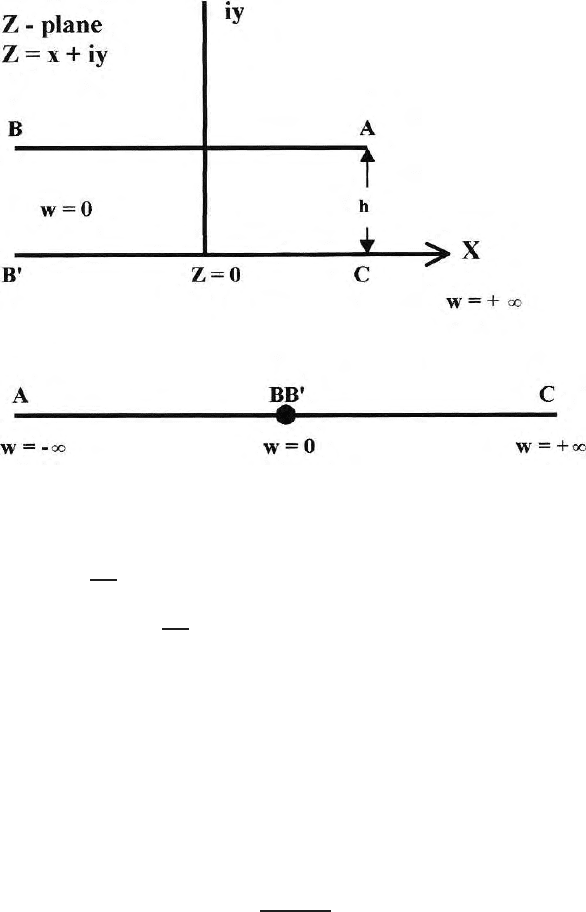
9.6 Geophysical Problems on S-C Transformation 279
Fig. 9.8. ( a) S-C transformation of a horizontal overburden of uniform thichness
over a resistive basement in the Z plane; (b) Map on to the real axis of the W plane
dz
dw
=A(w− 0)
−π/π
because w = 0 at BB
′
(9.75)
dz = A
dw
w
z=A1nw+C
1
(9.76)
This is the transformation function which maps the z = x + iy plane onto
the real axis of the w = u + iν plane. Now to solve the problem completely
we hav e to determine ‘A’ and ‘C
1
’. The constant ‘A’ can be determined as
follows. As we move from A
′
to C
′
over a large semicircle from π to 0, the
movement in the z-plane is – ‘ih’, where ‘h’ is the thickness of the substratum
and the vertical axis is the imaginary axis.
Let w = Re
iθ
.AsR→∞the (9.75) reduces to the form
−ih = A
0
π
iRe
iθ
dθ
Re
iθ
=A
0
π
idθ (9.77)
or
A=h/π
We can choose the origin in such a way that the constant of integration
becomes zero. If we choo se z = 0 at w = 1. Then C
1
= 0. And our origin
is fixed at w = 1. Therefore,

280 9 Complex Variables and Conformal Transformation in Poten tial Theory
z=
h
π
ln w (9.78)
and
u=e
πx/h
. cos (πy/h) (9.79)
ν =e
πx/h
. sin (πy/h) . (9.80)
Position of the current source I is u = −1, and potential in the w-plane φ
w
is
given by
φ
w
=
Iρ
π
ln
l
r
(9.81)
where r is the distance between the position of the source and the point of
measurement. In the w-plane
r={(u + l)
2
+ ν
2
}
1/2
therefore
φ
w
= −
Iρ
2π
ln
(u + l)
2
+ ν
2
.
In the z plane
φ
z
= −
Iρ
2π
ln
e
2πx/h
+2.e
πx/h
cos (πy/h) + l
. (9.82)
For y = h
φ
z
= −
Iρ
2π
ln
e
2πx/h
+2.e
πx/h
+l
(9.83)
=
Iρ
π
ln
e
πx/h
− 1
. (9.84)
9.6.2 Problem 2 Telluric Field over a Vertical Basement Fault
The geometry of the problem is shown is Fig. (9.9 a, b,). The problem was
solved independently by Kunetz and de Gery (1956), Berdichevsku, M.N.
(1950), Li. Y. Shu (1963). Here the basement is assumed to be vertically
faulted. The thicknesses of the sedimentary layer on the downthrow and
upthrow sides are ‘H’ a n d ‘h’ respectively. ρ
1
, the resistivity of the sedimen-
tary column, is assumed to be unity. ρ
2
, the resistivity of the basement, is
considered to be infinitely high (ρ
2
= ∞). Since the areas adjacent to the
fault planes are suitable sites for oil accumulation, telluric current method is
used as a reconnaissance to ol for location of these fault planes.
Telluric currents or earth currents originate due to interaction of the
earth’s natural electromagnetic field with the earth’s crust. Earth’s natu-
ral electromagnetic field originates due to interaction of the solar flares with
the magnetosphere of the earth. Telluric current sources are assumed to be
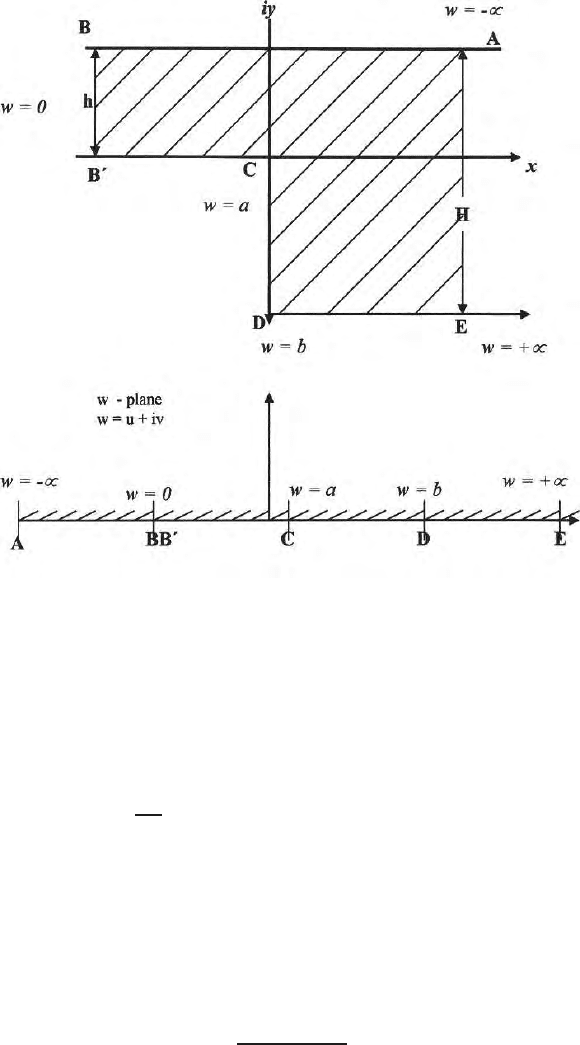
9.6 Geophysical Problems on S-C Transformation 281
Fig. 9.9. (a) S - C Transformation of a vertical fault type of structure in the plane;
(b) Map on to the real axis of the W plane
infinitely long line current sources placed at infinity such that uniform field is
created.
The Schwarz-Christoffel transformation function, which maps the struc-
ture in the z-plane onto the real axis of the w-plane, is given by
dz
dw
=Aw
−1
(w −a)
1/2
(w − b)
−1/2
(9.85)
because the corners crossed are a t BB’, C and D; the correspon di ng angles are
π, −π/
2
and +π/
2
. The change in angles at C and D are π/
2
in both cases.
At the point C the movement is away from the polygon and at the p oint D
the movement is towards the polygon. Hence there will be change in sign at
C and D. This step is important to get the starting integral correctly before
SC transformation starts.
Here
z=A
(w −a)
1/2
w(w− b)
1/2
dw + C
1
(9.86)
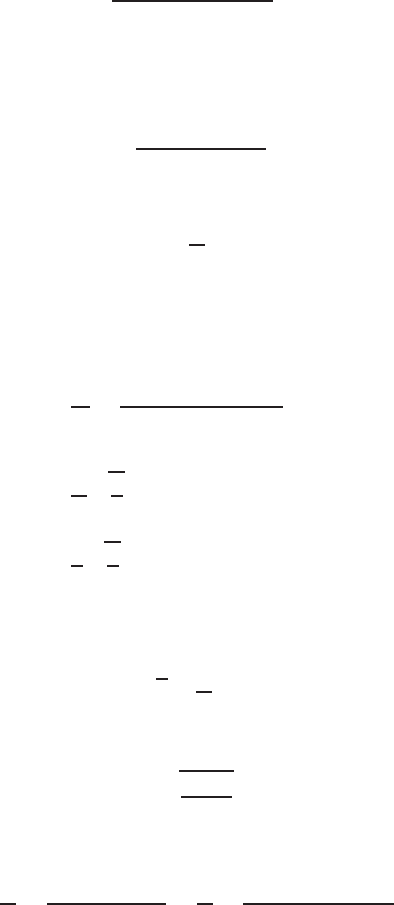
282 9 Complex Variables and Conformal Transformation in Poten tial Theory
where A is a constant to be determined. Applying the first boundary condition,
i.e. we integrate the (9.86) over a large semicircle of radius R(→∞)asw
changes from −∞ to + ∞ and θ varies from 0 to π. The movement in the
z-plane is – iH. Therefore, we have
−iH = A
0
π
Re
iθ
− a
y
2
Re
iθ
Re
iθ
− b
1/
2
iRe
iθ
dθ. (9.87)
Since R is infinitely large, (9.87) reduces to the form
−iH = A
o
π
Re
iθ
1/
2
Re
iθ
Re
iθ
1/
2
iRe
iθ
dθ
or
A=
H
π
. (9.88)
We next apply the second bound ary condition i.e. we integrate (9.86) over an
infinitesimal semicircle around BB’ with w = re
iθ
where r → 0andθ varies
from π to 0. The movement in the z-plane is –ih. Hence
−ih =
H
π
0
π
Re
iθ
− a
1/2
Re
iθ
Re
iθ
− b
1/2
iRe
iθ
dθ
=
H
π
0
a
b
0
π
idθ
=
h
π
0
a
b
. (9.89)
Since in this problem one of the values of a or b can be chosen arbitra rily.
We choose the value of a = 1, therefore
√
b=
H
h
. (9.90)
The integral (9.86) can be solved with the substitution of
t=
0
w − 1
w − b
sincea=1,wecanwrite
z=
H
π
(w − 1)
1/2
dw
w(w− b)
1/2
=
H
π
2t
2
(1 −b) dt
(t
2
− 1)
bt
2
− 1
(9.91)
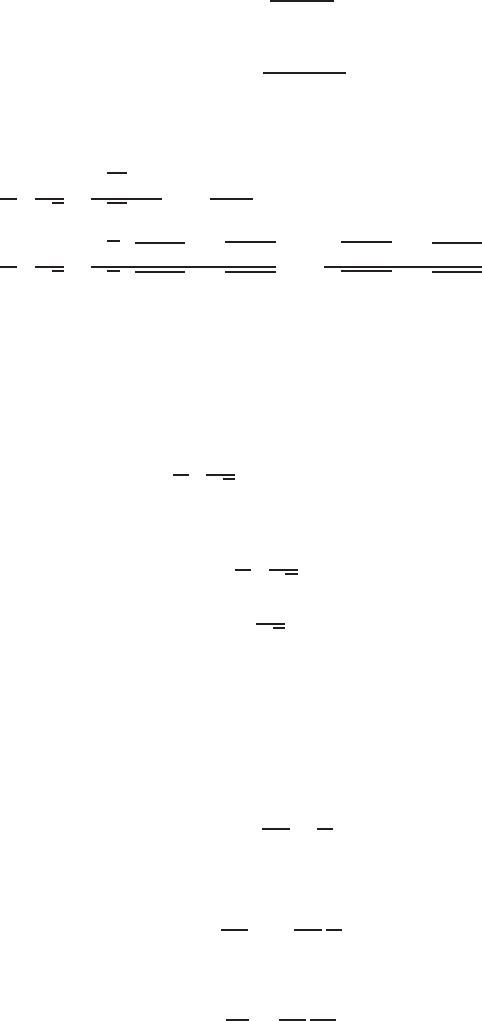
9.6 Geophysical Problems on S-C Transformation 283
because
w=
bt
2
− 1
t
2
− 1
and
dw =
2t (1 − b)
(t
2
− 1)
2
.
The integral can be solved by the well known method of partial fraction and
it reduces to the form
z=
H
π
)
1
√
b
ln
√
bt −1
√
bt + 1
+ln
1+t
1 −t
*
+C
1
(9.92)
z=
H
π
)
1
√
b
ln
√
b
√
w − 1 −
√
w − b
√
b
√
w − 1+
√
w − b
+ln
√
w − b+
√
w −1
√
w − b −
√
w −1
*
+C
1
. (9.93)
Equation (9.93) is the required mapping function for transformation of the
geometry from the z-plane to the w-plane. Now in order to determine the
value of C
1
, we fix the origin in the z-plane at w = 1. Fixing the origin within
the prescribed geometry of the z-plane is at our disposal. We can fix the origin
at any point we want. Now if z = 0 at w = 1, we get from (9.93).
0=
H
π
1
√
b
ln (−1) + ln (1)
+C
1
or
0=
H
π
1
√
b
.iπ
+C
1
C
1
= −i
H
√
b
= −ih. (9.94)
Computation of Telluric Field
In order to compute the telluric field, the source and sink are assumed to be
at infinity. The source is at z = −∞, at w = 0 and the sink is at z = +∞,
and w = −∞, the expression for the telluric field in given by
φ =
Iρ
1
π
ln
1
w
. (9.95)
Since the source and sink are assumed to be the infinitely long line electrodes,
therefore
dφ
dw
= −
Iρ
1
π
1
w
(9.96)
The expression for the telluric field in the z-plane is
dφ
dz
=
dφ
dw
dw
dz

284 9 Complex Variables and Conformal Transformation in Poten tial Theory
or
dφ
dx
=
dφ
du
du
dx
. (9.97)
Since the measurements are taken on the surface and on the real axis of the
wplaneν = 0, therefore
dw
dz
=
du
dx
. (9.98)
Again for a particular geometry of the structure y = const ≡ ih and dz = dx.
Therefore telluric field can be computed from the (9.97) where the expressions
for
dφ
du
and
du
dx
are known.
9.6.3 Problem 3 Telluric Field and Apparent Resistivity
Over an Anticline
This is also a similar type of boundary value problem a s discussed in the
previous section i.e., in connection with flow of telluric currents over basement
structure. Important points to be highlighted are: (i) close form solution of
this problem is not possible, therefore one has to use numerical methods for
solution of a part of this problem (i i) movements in the complex plane from
thetipoftheanticlineandthetrajectory of movement are demonstrated .
A two dimensional model of an anticline is shown in (Fig. 9.11 a,b) ECABD
is the infinitely resistive basement and D
′
E
′
is the earth surface. The domain
delineated by the polygonal boundary ECABD D
′
E
′
is filled with a medium
of finite resistivity (ρ = 1). Telluric currents, far away from the structure, are
assumed to be horizontal current sheets confined to the channel bounded by
the surface and the basement. The thickness of the overburden, away from
the structure, is assumed to be unity. (Roy a nd Naidu 1970).
Potential distribution in a homogeneous and isotropic medium and in a
source free region is given by the Laplace’s equation
∂
2
φ (x, y)
∂x
2
+
∂
2
φ (x, y)
∂y
2
=0. (9.99)
The method of Schwarz-Christoffel transformation is used for conformal map-
ping. The transformation maps the complex geometry of the problem onto a
simple geometry consisting of whole of the positive w-plane and the boundary
along the u-axis while keeping the Laplace’s equation and the boundary con-
ditions invariant. Since ECABD D
′
E
′
is a five cornered polygon, there will be
fivetermsofthetype(w− a
n
)
−a
n
/π
where n = 1 ......5, out of which three
may be chosen arbitrarily. The choices are as follows (9.10 a,b)
a
1
= ±∞ (Corresponding to EE
′
)
a
2
= −k (Corresponding to C)
a
3
= 0 (Corresponding to A
a
4
= 1 (Corresponding to B)
a
5
= 1 (Corresponding to DD
′
)
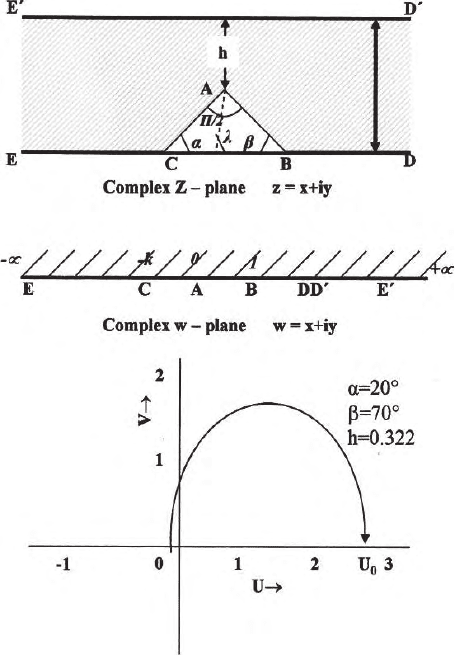
9.6 Geophysical Problems on S-C Transformation 285
(a)
(b)
(c)
Fig. 9.10. (a) Map of the basement asymmetric anticline in the Z plane; (b)its
map onto the real axis of the W plane; (c) trajectory in the W plane of vertical
mo vement from the tip of the anticle A to the epicentre of A on the surface in the
Zplane
and the arguments α
1
, α
2
, α
3
, α
4
, α
5
are given as follows
α
5
= π (Corresponding to EE
′
)
α
2
= α (Corresponding to C)
α
3
= −(α + β) (Corresponding to A)
α
4
= β (Corre sponding to B)
α
5
= π (Corresponding to DD
′
)
Hence the Schwarz – Christoffel transformation function for the present prob-
lem may be expressed in the differential form as
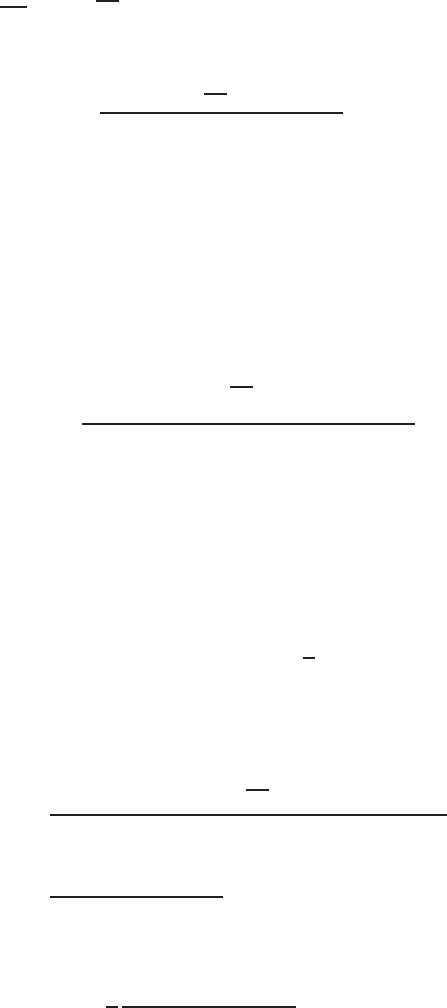
286 9 Complex Variables and Conformal Transformation in Poten tial Theory
dz
dw
=A
1
w
α+β
π
(w + k)
−α/π
(w − l)
−β/π
(w − l)
−1
(9.100)
which can be rewritten as
z=A
w
0
w
α+β
π
dw
(w + k)
α/π
(w − l )
β/π
(w − l)
+C. (9.101)
The term corresponding to the point EE
′
does not enter into the differen-
tial equation because the value of w at E and E
′
are ±∞. The constant of
integration is C = 0 because the origin i n the z-plane is fixed.
The evaluations of the unknowns A
1
,...k are attempted using the follow-
ing boundary conditions. Equation (9.101) is integrated at a point A along a
semiinfinite circle in the upper half of the w-plane. Substituting w = Re
iθ
and
R →∞.
One gets
z=A
1
0
π
Re
iθ
α+β
π
iRe
iθ
dθ
Re
iθ
+k
α/π
Re
iθ
− l
β/π
Re
iθ
− l
(9.102)
By moving in an infinitely large semicircle from to 0 to π along the upper half
of the w-plane, the corresponding movement in the z-plane is from E to E
′
,
i.e. ‘iH’ where ‘H’ is the thickness of the overburden (assumed to be unity).
So z = iH = i
As R →∞the integral reduces to
i=A
1
0
π
idθ or A
1
= −
1
π
. (9.103)
Next the (9.101) is integrated along an infinitesimal semicircle ar ound DD
′
in
the upper half of the w-plane. Substituting w = 1 + re
iθ
as r → 0, one gets
z=A
1
0
π
1+re
iθ
α+β
π
ire
iθ
dθ
(1 + re
iθ
+k)
α/π
(1 + re
iθ
− ℓ)
β/π
(1 + re
iθ
− 1)
i=A
1
0
idθ
(1 + k)
α/π
(1 −ℓ)
β/π
because movement in the z-plane is from D to D
′
which is ‘iH’ or simply ‘i’.
Therefore
i=
1
π
1
(1 + k)
α/π
(1 −1)
β/π
− iπ
Or
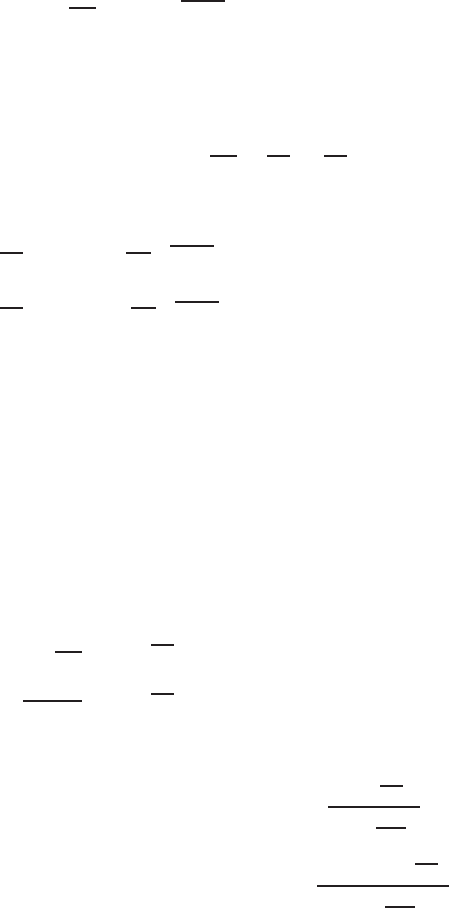
9.6 Geophysical Problems on S-C Transformation 287
k=(1−ℓ)
β/α
− 1. (9.104)
One more equation is required to solve for ‘k’ and ‘1’ uniquely. The following
procedure is adopted. The inverse of the (9.98) is written as
dw
dz
=A
−1
1
w
−(α+β)
π
(w + k)
α/π
(w − ℓ)
β/π
(w − 1) . (9.105)
A solution of the differential equation in a closed form is not possible
except when both α/π and β/π can be expressed as ratio of two integers.
Hence (9.105) has to be solved numerically.
Since
dw
dz
=
dv
dy
− i
du
dy
One gets
dv
dy
=+Real
1
A
1
w
−(α+β)
π
(w + k)
α/π
(w − ℓ)
β/π
(w −1)
(9.106)
du
dy
=+Imag
1
A
1
w
−(α+β)
π
(w + k)
α/π
(w − ℓ)
β/π
(w − 1)
. (9.107)
Values of ‘k’ and ‘1’ are selected and the system of (9.106) and (9.107) are
integrated from y = 0 to y = h keeping x constant (here x = 0). While
integrating numerically the point in the w-plane describes a trajectory which
commences at the origin and ends somewhere on the positive part of the
real axis (Fig. 9.11c). This point represents the projection of the vertex of
the triangle, it is termed as ‘epicentre’ U
0
. Of course, the initial condition
is u = v = 0 when y = 0. But at this point the integrands (9.106) and
(9.107) are singular. They have an algebraic singularity and as a result a
numerical solution cannot be initiated at this point. This difficulty is avoided
by obtaining an asymptotic solution. Instead of starting y = 0, it is necessary
to start at y = ∂ywhere∂y << 1 as follows.
dz
dw
=A
1
w
α+β
π
(w + k)
−α/π
(w − ℓ)
−β/π
(w −1)
−1
(9.108)
dz
dw
w=0
=A
1
w
α+β
π
(k)
−α/π
(ℓ)
−β/π
(−1)
−1
. (9.109)
Therefore
z=−A
1
(k)
−α/π
(−ℓ)
−β/π
w
(
1+
α+β
π
)
1+
α+β
π
(9.110)
= −A
1.
(k)
−α/π
(ℓ)
−β/π
(u + iv)
(
1+
α+β
π
)
1+
α+β
π
. (9.111)
Hence
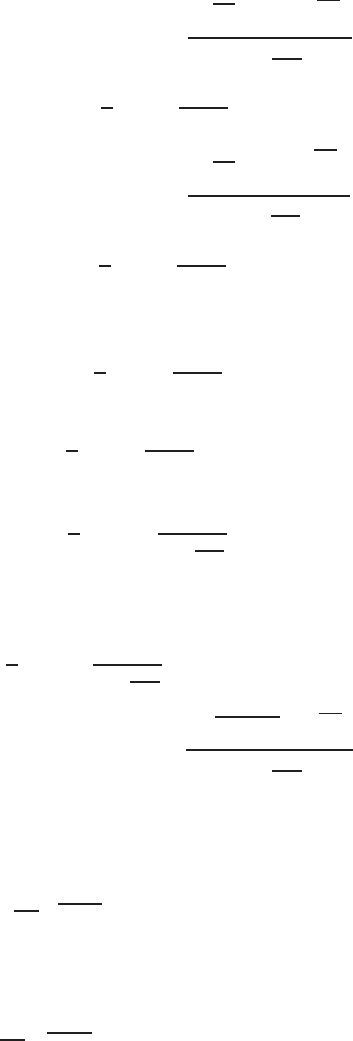
288 9 Complex Variables and Conformal Transformation in Poten tial Theory
x=− A
1
. (k)
−α/π
(ℓ)
−β/π
√
u
2
+v
2
(
1+
α+β
π
)
1+
α+β
π
(9.112)
cos
tan
−1
v
u
x
1+
α + β
π
− β
y=− A
1
. (k)
−α/π
(ℓ)
−β/π
√
u
2
+v
2
(
1+
α+β
π
)
1+
α+β
π
(9.113)
sin
tan
−1
v
u
x
1+
α + β
π
− β
.
Since x = 0 through out the path
cos
tan
−1
v
u
x
1+
α + β
π
− β
= 0 (9.114)
or
tan
−1
v
u
x
1+
α + β
π
− β
= π/2.
Hence
v
u
=tan
π/2+β
1+
α+β
π
. (9.115)
Either v or u may be chosen arbitrarily such that it is very nearly equal to
zero. Then
v
0
=
v
u
u
0
tan
π/2+β
1+
α+β
π
. (9.116)
y
0
= −A
1
. (k)
−α/π
(ℓ)
−β/π
u
2
0
+v
2
0
(
1+
α+β
π
)
1+
α+β
π
. (9.117)
It is now p ossible to integrate the (9.116) and (9.117) numerically. The pro-
jection of the epicentre is given by
u
0
= −
h
0
Im ag
1
A
1
w
−(α+β)
π
(w + k)
α/π
(w − ℓ)
β/π
(w −1)
dy. (9.118)
and
0=−
h
0
Real
1
A
1
w
−(α+β)
π
(w + k)
α/π
(w − ℓ)
β/π
(w −1)
dy. (9.119)
